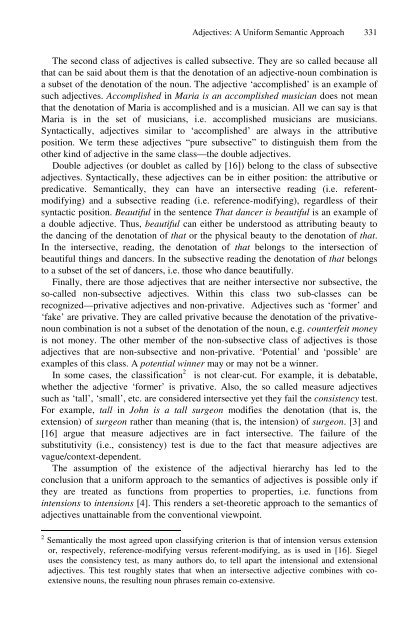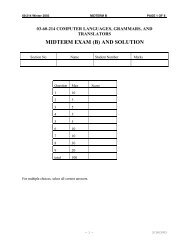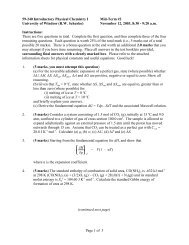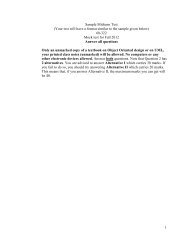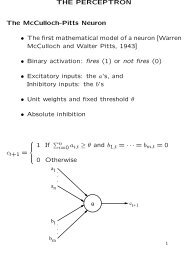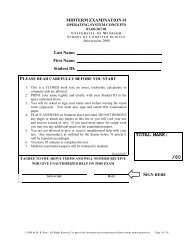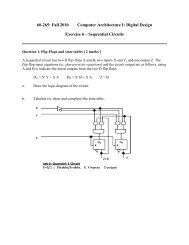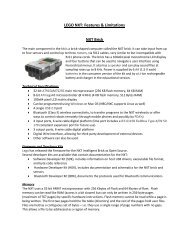Adjectives: A Uniform Semantic Approach - University of Windsor
Adjectives: A Uniform Semantic Approach - University of Windsor
Adjectives: A Uniform Semantic Approach - University of Windsor
Create successful ePaper yourself
Turn your PDF publications into a flip-book with our unique Google optimized e-Paper software.
<strong>Adjectives</strong>: A <strong>Uniform</strong> <strong>Semantic</strong> <strong>Approach</strong> 331<br />
The second class <strong>of</strong> adjectives is called subsective. They are so called because all<br />
that can be said about them is that the denotation <strong>of</strong> an adjective-noun combination is<br />
a subset <strong>of</strong> the denotation <strong>of</strong> the noun. The adjective ‘accomplished’ is an example <strong>of</strong><br />
such adjectives. Accomplished in Maria is an accomplished musician does not mean<br />
that the denotation <strong>of</strong> Maria is accomplished and is a musician. All we can say is that<br />
Maria is in the set <strong>of</strong> musicians, i.e. accomplished musicians are musicians.<br />
Syntactically, adjectives similar to ‘accomplished’ are always in the attributive<br />
position. We term these adjectives “pure subsective” to distinguish them from the<br />
other kind <strong>of</strong> adjective in the same class—the double adjectives.<br />
Double adjectives (or doublet as called by [16]) belong to the class <strong>of</strong> subsective<br />
adjectives. Syntactically, these adjectives can be in either position: the attributive or<br />
predicative. <strong>Semantic</strong>ally, they can have an intersective reading (i.e. referentmodifying)<br />
and a subsective reading (i.e. reference-modifying), regardless <strong>of</strong> their<br />
syntactic position. Beautiful in the sentence That dancer is beautiful is an example <strong>of</strong><br />
a double adjective. Thus, beautiful can either be understood as attributing beauty to<br />
the dancing <strong>of</strong> the denotation <strong>of</strong> that or the physical beauty to the denotation <strong>of</strong> that.<br />
In the intersective, reading, the denotation <strong>of</strong> that belongs to the intersection <strong>of</strong><br />
beautiful things and dancers. In the subsective reading the denotation <strong>of</strong> that belongs<br />
to a subset <strong>of</strong> the set <strong>of</strong> dancers, i.e. those who dance beautifully.<br />
Finally, there are those adjectives that are neither intersective nor subsective, the<br />
so-called non-subsective adjectives. Within this class two sub-classes can be<br />
recognized—privative adjectives and non-privative. <strong>Adjectives</strong> such as ‘former’ and<br />
‘fake’ are privative. They are called privative because the denotation <strong>of</strong> the privativenoun<br />
combination is not a subset <strong>of</strong> the denotation <strong>of</strong> the noun, e.g. counterfeit money<br />
is not money. The other member <strong>of</strong> the non-subsective class <strong>of</strong> adjectives is those<br />
adjectives that are non-subsective and non-privative. ‘Potential’ and ‘possible’ are<br />
examples <strong>of</strong> this class. A potential winner may or may not be a winner.<br />
In some cases, the classification 2 is not clear-cut. For example, it is debatable,<br />
whether the adjective ‘former’ is privative. Also, the so called measure adjectives<br />
such as ‘tall’, ‘small’, etc. are considered intersective yet they fail the consistency test.<br />
For example, tall in John is a tall surgeon modifies the denotation (that is, the<br />
extension) <strong>of</strong> surgeon rather than meaning (that is, the intension) <strong>of</strong> surgeon. [3] and<br />
[16] argue that measure adjectives are in fact intersective. The failure <strong>of</strong> the<br />
substitutivity (i.e., consistency) test is due to the fact that measure adjectives are<br />
vague/context-dependent.<br />
The assumption <strong>of</strong> the existence <strong>of</strong> the adjectival hierarchy has led to the<br />
conclusion that a uniform approach to the semantics <strong>of</strong> adjectives is possible only if<br />
they are treated as functions from properties to properties, i.e. functions from<br />
intensions to intensions [4]. This renders a set-theoretic approach to the semantics <strong>of</strong><br />
adjectives unattainable from the conventional viewpoint.<br />
2 <strong>Semantic</strong>ally the most agreed upon classifying criterion is that <strong>of</strong> intension versus extension<br />
or, respectively, reference-modifying versus referent-modifying, as is used in [16]. Siegel<br />
uses the consistency test, as many authors do, to tell apart the intensional and extensional<br />
adjectives. This test roughly states that when an intersective adjective combines with coextensive<br />
nouns, the resulting noun phrases remain co-extensive.


